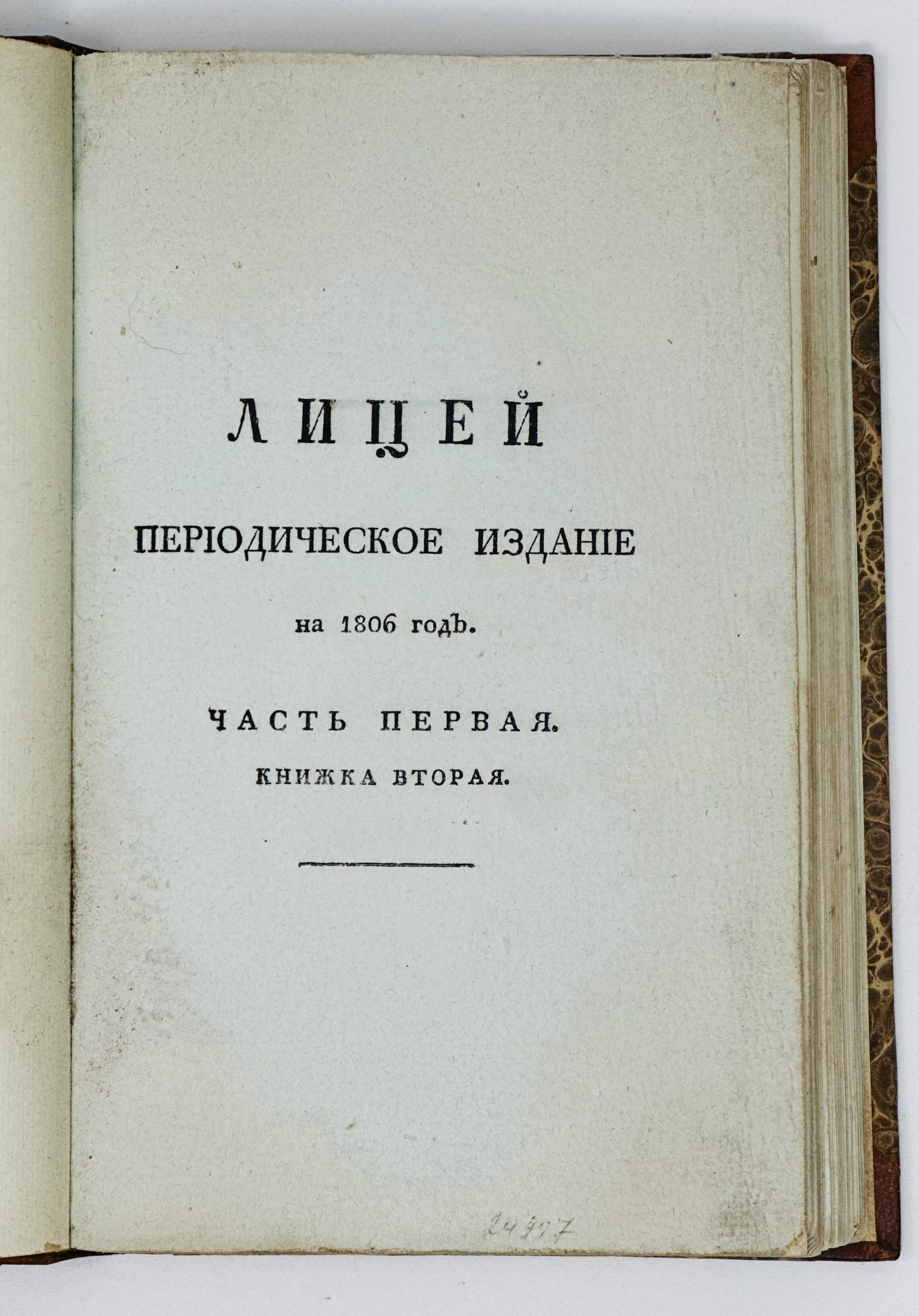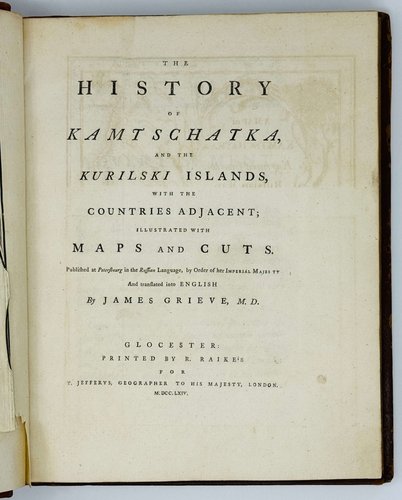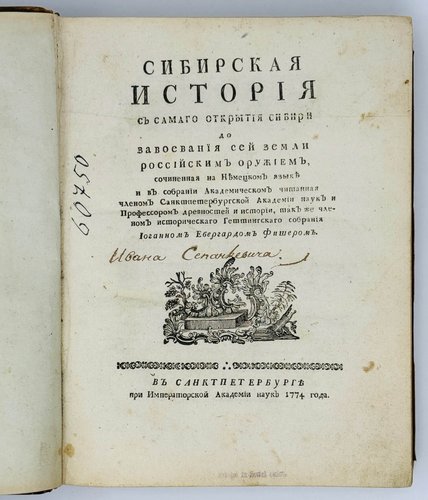



#RA52
[1806]
First and only Russian edition. Octavo (ca. 21x13 cm). [2 – half title], 1-108 pp. Period style brown quarter sheep with marbled papered boards; spine with gilt-tooled decorations and a green label with a gilt-lettered title. Mild water stains in the text, but overall a very good copy.
Very rare Russian imprint with only two paper copies found in Worldcat - Yale University and New York Public Library (both holding complete sets of the magazine, comprising four parts, each in three books, all published in 1806; no holdings of odd volumes found).
Rare, early, little-known original overview of Russian exploration of the North Pacific and Alaska, including Semyon Dezhneyov’s discovery of the Bering Strait, Vitus Bering’s Great Northern Expedition (1733-1743), voyages of Russian fur hunters to the Aleutian Islands in the second half of the 18th century, and a secret expedition to the Bering Strait and Alaska under command of Lt. Johann Sind in 1764-68.
The article opens a nine-part series, published under the same title - “A Relation about Voyages of the Russians around the World” - in a little-known Saint Petersburg literary and philosophical magazine, “Litsey,” which existed for one year only (1806). The publication took place shortly after the return of the First Russian circumnavigation under the command of Adam von Krusenstern and Yury Lisiansky (1803-1806) and aimed to “overview which successes the Russians had in the past times, about discoveries of new lands, and which travels and when they undertook overall” (Litsey. 1806. Part 1, book 2, pp. 37-38). The first article in the series talks about Russian discoveries in the Arctic and North Pacific from the reign of Ivan the Terrible to the end of the 18th century. The second article (Litsey, part 2, book 1) describes two Arctic voyages of Vasily Chichagov (1765 and 1766) and the Northeastern expedition (1785-1793) of Joseph Billings; the following five articles (Litsey, part 2, books 2 & 3; part 3, books 1, 2 & 3) give a detailed account of the first Russian embassy to Japan, led by Adam Laxman in 1792-1793. The last two articles (Litsey, part 4, books 2 & 3) provide one of the earliest Russian printed accounts of the First Russian circumnavigation, based on the “excerpts from a diary of a person, entrusted by the [Russian] American Company, about the expedition, sent in 1803 on a voyage around the world” (Litsey. 1806. Part 1, book 2, p. 37) – possibly, by merchant Fedor Shemelin (1750s - after 1834), who travelled on Krusenstern’s sloop “Nadezhda” as a commissioner of the Russian American Company and later published his account of the circumnavigation. All articles in the series published in the “Litsey” magazine are rare and are early original Russian publications, which have remained little-known to historians.
The first article, published in the present copy of the “Litsey,” starts with the relation of the Russian discoveries in the Arctic and North Pacific Oceans during the reigns of Ivan the Terrible (1530-1584) and his son Feodor I (1557-1598). The author talks about the expedition to the “Icy Sea,” which “continuously went along its coast to the north-east, and one of its small ships went around its furthest cape – the Chukotka Nose – and safely crossed the Kamchatka or the Pacific Sea and arrived in the lower Kamchatka” (pp. 88-89). Most likely, this is a wrongly dated description of the exploratory expedition of Semyon Dezhnyov, who in 1648 became the first European to sail through the Bering Strait (eighty years before the formal discovery by Vitus Bering). Then follows a brief account of Vitus Bering’s First Kamchatka Expedition (1725-1730) and the discovery of the Bering Strait (p. 89). Two pages (pp. 90-91) describe the voyages and discoveries of the Great Northern Expedition – by Vitus Bering, Alexey Chirikov, Academicians Georg Mueller, Georg Steller, Johann Gmelin, Stepan Krasheninnikov, and others. The author also talks about the famous map of Russian discoveries in the North Pacific, published in 1758 [“Nouvelle Carte des Decouvertes faites par des Vaisseaux Russiens aux Cotes Inconnues de L'Amerique Septentrionale…” St. Petersbourg: l'Academie Imperiale des Sciences, 1758], and the foundation of the “company of Russian merchants with a special privilege to voyage and trade in the newly discovered countries <…> across from the Olyutor Gulf” by the permission of Catherine the Great (p. 91).
The last part of the article (pp. 92-94) is a story of the secret Russian expedition to the North Pacific and the Northwest coast of America under the command of Russian Lieutenant Johann Sind/Sindt in 1764-68. “In 1764, the merchants went by galiots and Siberian vessels under the command of Lieutenant of the Admiralty, Sind, from the Okhotsk harbour around the Southern Kamchatka Cape to the Kamchatka Sea, continuing their voyage north along the eastern coast, and in 1765 ad 1766 discovered between 56° and 57° northern latitudes many big and small islands…” (p. 92). In fact, Sind discovered St. Matthew Island (Alaska, USA), approached the Seward Peninsula of Alaska and mistook the capes of St. Lawrence Island for several islands. In the end, the author describes the islands of the “Northern Archipelago,” east of Kamchatka: “About these islands, it is generally only known that the ones situated between 50° and 55° northern latitudes, in regards to weather, sea and land flora, animals, fish, shells, and also in regards to the appearance, clothing, food, manners and customs of the inhabitants, are similar to the Kurile Islands. The ones lying from 55° to 60° - the Olyutor and Aleut Islands, are similar to Kamchatka, but the ones located between 60° and 67°, i.e. in the Bering Strait, are quite different. The ones similar to Kamchatka are mostly mountainous and rich in ores, but there is almost no forest and flat land. On the contrary, the islands further north are rich in forests, fields and game; as to the savage inhabitants of the latter islands, in their appearance, manners and customs, they are the antipodes of the courteous and gracious Tahitians” (pp. 93-94).
Overall, this is an important early, little-known Russian account of Russian discoveries in the North Pacific and along the Alaskan coast. The author was Ivan Martynov, the publisher of the “Litsey” magazine, a Saint Petersburg philologist, translator, and educator, a member of the Russian Academy, and the author of the statutes of several Russian Universities.
The “Litsey” magazine was issued in 1806 only and consisted of four parts (each in three books); its main body contains translations from ancient Greek, Roman, and European writers (Jean de La Fontaine, Christoph Wieland, Gotthold Lessing, Jean Paul Richter, and others) and works of contemporary Russian poets. The magazine also included articles on political and cultural topics, relations from the Russian Academy of Sciences, accounts of contemporary travels and voyages, reviews on the latest theatre performances, &c.











